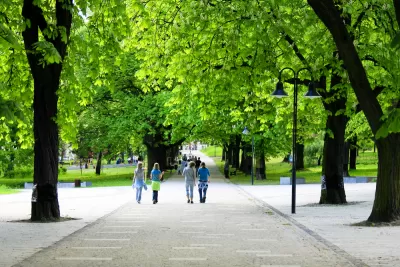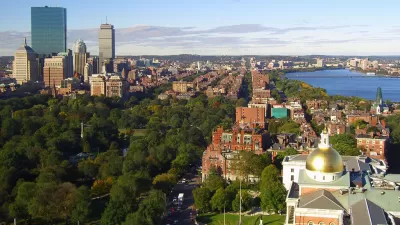As temperatures rise, there are some relatively simple changes cities can implement to cut cooling costs and deal with spells of extreme heat.

According to one study, the number of days in a year across the United States that feel hotter than 100 degrees Fahrenheit will more than double by mid-century. That's bad news for cities designed in ways that often exacerbate urban heat, Adele Peters writes. While broad infrastructural changes (and, ultimately, the elimination of fossil fuels) will do the most to combat an even hotter future, simple mitigation methods do exist for the heat that cities are already feeling.
When it comes to planting urban trees, "There are multiple benefits, but one is simple: As trees shade streets, and water evaporates from their leaves, they cool neighborhoods." Cities like Melbourne, Milan, and Madrid are all engaged in ambitious plans to grow out their urban forests.
Other cities, like New York, Los Angeles, and Tokyo, are covering rooftops and pavements with reflective coating. "The coating helps lower temperatures inside buildings, helping people feel more comfortable and use less air conditioning; like cars, air conditioners are both another major source of emissions and make cities immediately hotter as the machines vent heat outside."
Another way to fight urban heat is to equip structures with "smart" systems like automatic shades and windows programmed to respond to heat conditions, and to choose building materials with heat mitigation in mind. In the end, Peters notes, reducing automobile dependence will also play a role. "Cities that incentivize less driving—whether by redesigning bike lanes and sidewalks or changing codes to make new developments mixed-use and near public transportation—can cool themselves down."
FULL STORY: Cities are getting hotter, but we can redesign them to keep us cool

Maui's Vacation Rental Debate Turns Ugly
Verbal attacks, misinformation campaigns and fistfights plague a high-stakes debate to convert thousands of vacation rentals into long-term housing.

Planetizen Federal Action Tracker
A weekly monitor of how Trump’s orders and actions are impacting planners and planning in America.

Chicago’s Ghost Rails
Just beneath the surface of the modern city lie the remnants of its expansive early 20th-century streetcar system.

Bend, Oregon Zoning Reforms Prioritize Small-Scale Housing
The city altered its zoning code to allow multi-family housing and eliminated parking mandates citywide.

Amtrak Cutting Jobs, Funding to High-Speed Rail
The agency plans to cut 10 percent of its workforce and has confirmed it will not fund new high-speed rail projects.

LA Denies Basic Services to Unhoused Residents
The city has repeatedly failed to respond to requests for trash pickup at encampment sites, and eliminated a program that provided mobile showers and toilets.
Urban Design for Planners 1: Software Tools
This six-course series explores essential urban design concepts using open source software and equips planners with the tools they need to participate fully in the urban design process.
Planning for Universal Design
Learn the tools for implementing Universal Design in planning regulations.
planning NEXT
Appalachian Highlands Housing Partners
Mpact (founded as Rail~Volution)
City of Camden Redevelopment Agency
City of Astoria
City of Portland
City of Laramie




























